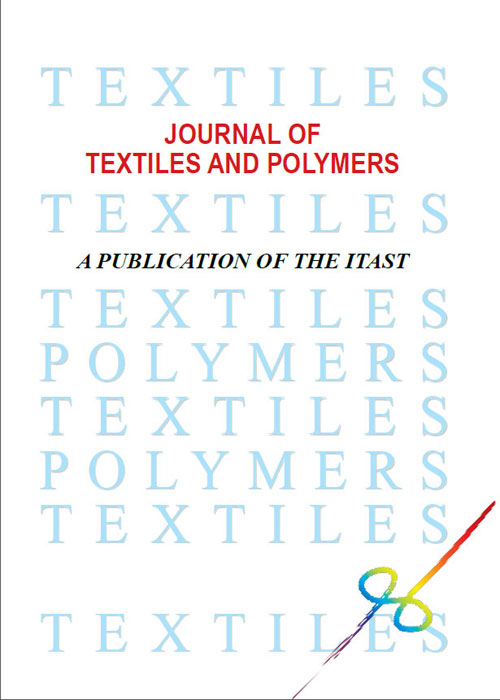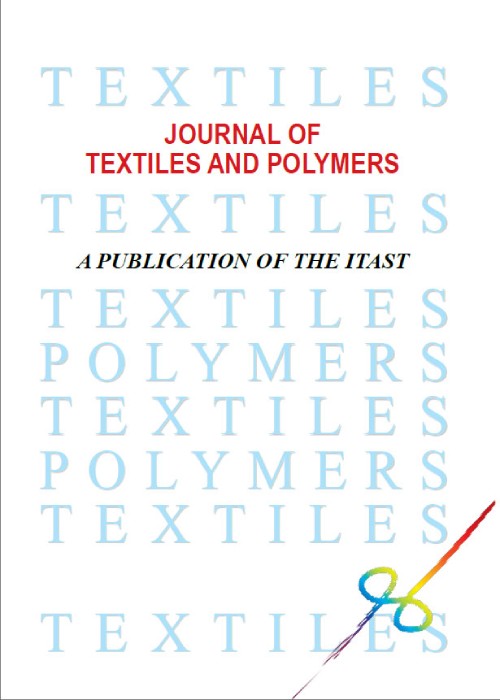فهرست مطالب

Journal of Textiles and Polymers
Volume:7 Issue: 2, Spring 2019
- تاریخ انتشار: 1398/03/11
- تعداد عناوین: 7
-
-
Pages 3-12Nanoaluminum tetraborate (Al2(B4O7)3) and nanoaluminum tungstate (Al2(WO3)3) were prepared by in situ precipitation method on the surface of cellulosic fibers to achieve flame retardant nanocomposite fibers. The prepared nanocomposite fibers were characterized by several techniques such as XRD, SEM, TEM, EDS, and FTIR. Al2(B4O7)3 and Al2(WO3)3 with less than 100 nm in size were dispersed throughout on the surface of the fibers without the formation of large aggregates which showed effective flame retardancy properties. It was found that loading 2.60% Al2(B4O7)3 and 4.95% Al2(WO3)3 onto the cellulosic fibers improved greatly the fl ame retardancy behavior of nanocomposite fibers which was approved by vertical flame test and limiting oxygen index (LOI) values. The thermal stability and amount of heat release of untreated and fl ame retardant fibers were evaluated by thermogravimetric (TGA) and differential scanning calorimetry (DSC) analyses. The results showed that the fl ame retardancy mechanism of the obtained flame retardant nanocomposite fibers probably is a condensed-phase phenomenon due to the formation of a protective char layer that acts as a mass transport barrier and a thermal insulator.Keywords: cellulosic fiber, Al2(B4O7)3, Al2(WO3)3, nanocomposite, flame-retardancy
-
Pages 13-24In this work, the specimen of the fabrics (polyester/viscose blend) was first placed under microwave irradiation at different times, and then the optimum treatment of treated fabrics (8 min) was selected for investigating physical properties and surface morphology. Graphene oxide (GO) and carbon nanotube (CNT) with different percentages were measured using dispersing agent, washing performance and wash stability, and physical properties of the fabric. Surface morphology of the specimens was also photographed by SEM electron microscopy. Finally, the conductivity properties of the specimens were measured according to AATCC 2005-76 standards, and analyzed by K/S, R%, and Lab specimens and the changes were obtained from the experiments using reflection spectrophotometer analysis. The optimum electrical conductivity was found for viscose polyester fabric containing 9% nanoparticles, and more interestingly, the electrical resistivity for the values of 7 and 5% of CNT were approximately the same as those of 9 and 7% of GO.Keywords: polyester, viscose blend fabric, multi-wall carbon nanotubes, graphene oxide nanoparticles, conductivity properties, reflective spectrophotometer, statistical analysis of the central composite design (CCD)
-
Pages 25-36In this study, the adsorption performance of a modified halloysite for the removal of anionic dye (C.I. Acid Blue 92) was demonstrated. Halloysite was modified in a multistep process by the synthesis of amine terminated dendritic structures on its surface. The transmission electron microscopy images were used to characterize the nanotubes forms of pristine halloysite. The adsorption processes were performed using classical and statistical response surface methodology (RSM) techniques. The effect of important parameters such as pH, adsorbent concentration, and dye dosage was investigated. The results showed that all the independent factors except time were significant to the dye removal efficiency. The dye removal at equilibrium time was well fitted to the Langmuir isotherm model and followed the monolayer adsorption style. The adsorption rate was also described by the pseudo-second-order kinetic model. The adsorption process revealed an exothermic behavior according to the thermodynamic investigations. The removal efficiency of AB92 improved significantly from 8% to 97% after modification.Keywords: halloysite, amine terminated dendritic structure, response surface methodology, removal, acid dye
-
Pages 37-46The development of electrospun nanofibers for using in different applications requires a comprehensive understanding of the mechanical properties of a single nanofiber and nanofiber layer. Here, we studied the mechanical properties of nanofiber layer and single nanofiber of polycaprolactone (PCL)/functionalized multiwall carbon nanotubes (F-MWCNTs) composite structures. Scanning electron microscopy (SEM) showed morphology and diameter of composite nanofibers with various CNT concentrations. Moreover, the tensile testing was used for measuring mechanical properties of both nanofiber layer and single nanofibers by distinct procedures. Our results clearly showed that the mechanical properties of single nanofibers had a significant difference with those of nanofiber layer. By increasing the F-MWCNT concentration up to 3 wt%, Young’s modulus and tensile strength of the nanofiber layer increased. However, Young’s modulus and tensile strength of single nanofiber increased with addition of F-MWCNTs up to 1 wt% and further increase in concentration led to a decrease in the modulus and tensile strength of single nanofiber.Moreover, the toughness and elongation-at-break of the nanofiber layer and single nanofiber showed different trends. Taken together, considering the mechanical properties of nanofibers in different scales, help us to design an appropriate structures for various applications.Keywords: composite nanofibers, carbon nanotubes, mechanical property, single nanofibers, nanofiber layer
-
Pages 47-64Bone tissue engineering is the most promising therapeutic method to alleviate the fast-growing request for bone grafts in nonunion bone defects. It is founded on the use of implanted autologous cells or induced stem cells to form bone tissues on naturally derived or synthetic scaffolds. Nanofibers are being increasingly implemented in bone tissue engineering field as scaffolding materials to regenerate new bone tissues owing to their high surface area-to-volume ratio, high porosity with an interconnected pore structure and the suitable surface structure for cell attachment, proliferation, and differentiation. PLA biopolymer has captured the most attention and interest as a bone tissue engineering material since PLA is easily processable and degrades and disintegrates into natural metabolites while its degradation rate matches with the healing time of damaged human bone tissues. So, the potential of using PLA nanofibers in bone tissue engineering is a serious goal for scientists in novel investigations. This review gives detailed information about the recent developments and applications of PLA nanofibers as scaffolds for bone tissue regeneration.Keywords: nanofiber, tissue engineering, poly(lactic acid), bone, scaffold
-
Pages 65-72Polylactide nonwoven was modified by poly(N,N-dimethylaminoethyl methacrylate). The surface was quaternizated with crosslinking. A two-step method was used: first spraying the polymer, then cross-linking with ethylene bromide. The modification was confirmed by infrared spectroscopy and solubility tests. The antibacterial activity of unmodified nonwoven, nonwoven with a deposited layer of PDMAEMA and nonwoven quaternized with PDMAEMA was evaluated against Escherichia coli and Staphylococcus aureus. The antibacterial results showed that these materials could achieve up to 100% efficiency.Keywords: poly(N, N-dimethylaminoethyl methacrylate), antibacterial properties, surface modification, quaternary ammonium salt
-
Pages 73-80Controlling the selvedge waste length in shuttle-less weaving loom has great importance in the cost of production. In this study, an online control system is designed and implemented in a weaving loom. First, a high-speed camera records selvedge formation in several successive cycles with different weft yarn tensions. Then the length of weft yarn waste is measured by three methods based on image processing, namely Kalman filter, K-means method and background subtraction. The performances of three methods in terms of accuracy and processing time are evaluated and compared with each other. The results show that Kalman filter method has higher accuracy and it requires lower processing time. In addition, it shows that the results obtained from two other methods are very close to the actual result. There is an inverse relationship between weft yarn tension and selvedge waste length. By increasing the yarn tension, waste length is decreased. Therefore, based on the online measurement of selvedge waste length, the waste length can be measured in each cycle and adjusted by changing the weft yarn tension. So the proposed system has satisfactory performance in online control of weft yarn waste.Keywords: rapier weaving, selvedge waste length, image processing technique, Kalman filter


